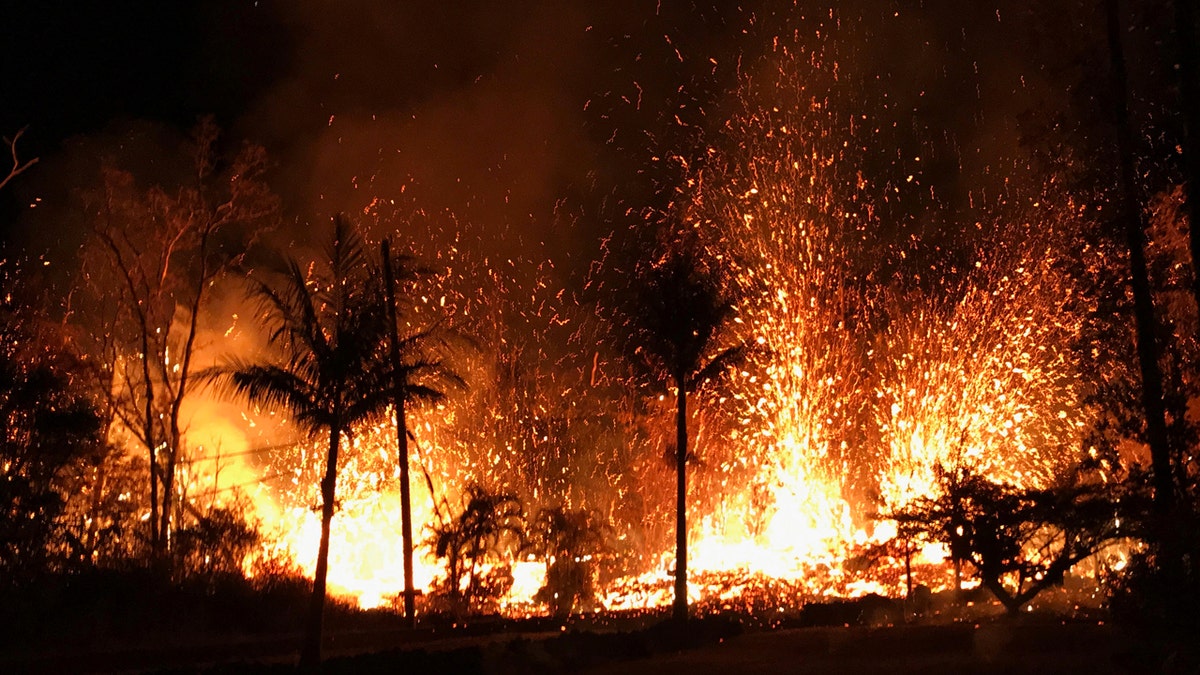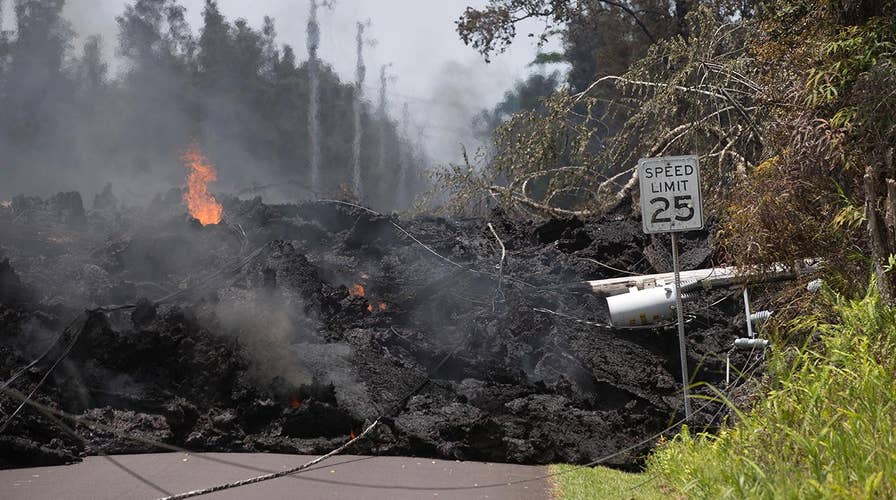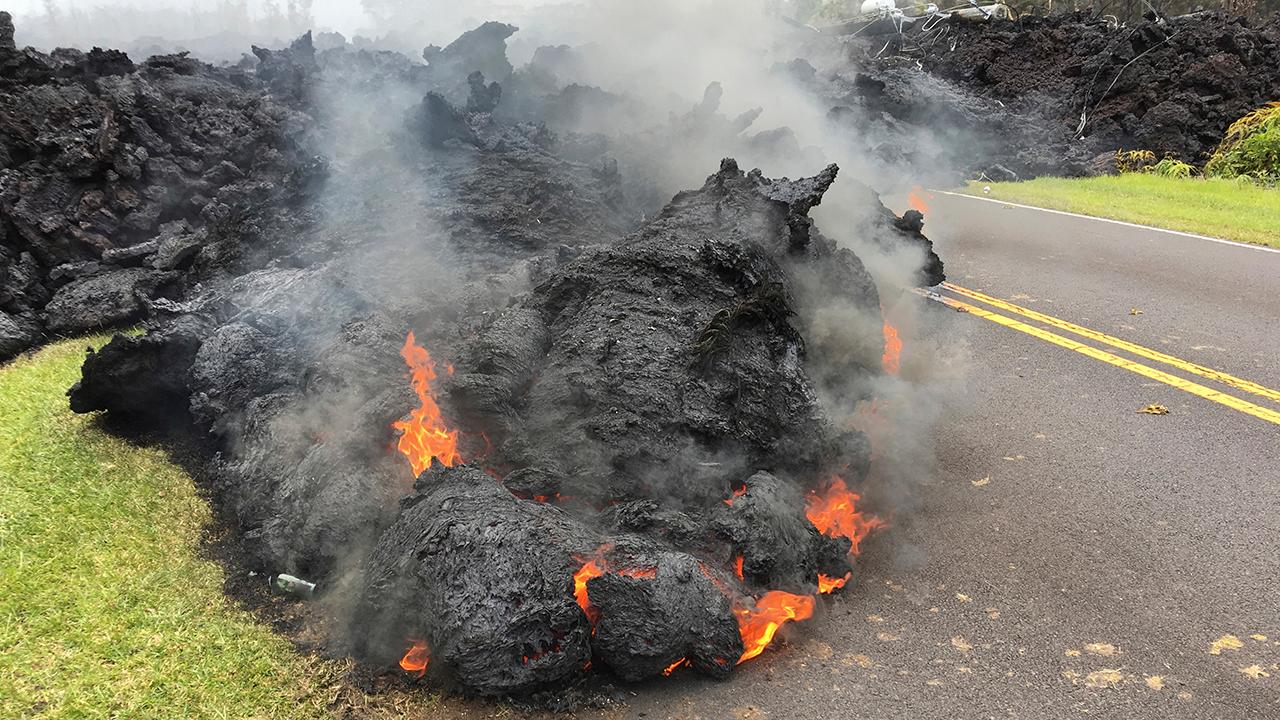Hawaii volcano lays waste to dozens of homes
Hawaii residents were allowed to enter the neighborhood again after the eruption. William La Jeunesse has the story.
Molten lava from Hawaii's Kilauea volcano continued gushing into the lush paradise on the Big Island Monday, even as an eleventh fissure opened up, destroying more than two dozen homes and spewing lava hundreds of feet in the air.
The 26 decimated homes were located in the Leilani Estates subdivision, where molten rock, toxic gas and steam have been bursting through openings in the ground created by the volcano, officials said. No fatalities or major injuries have been reported since the eruptions began Thursday.
Hawaii County Civil Defense Administrator Talmadge Magno told reporters on Sunday that some of the fissures “have established pretty good flows and just continue to cover more of the subdivision,” adding a sizeable lava flow was heading north of a new vent.
"There’s no sign of slowing down," he said. "We had some pauses yesterday, but it seems like there’s a lot of magma under the ground."
Magno added that “it seems like the flows are extending further from the fissures, so the eruption is progressing.”
Officials had told residents of Leilani Estates on the Big Island that they would be able to return to their homes but as of 6:40 a.m. local time, officers tell Fox News that has changed due to a line of cars waiting for hours to get in.
Additionally, on Highway 130, there is now another crack in the road that is about four or five inches thick, which officials said may be a sign something new may be happening. The whole highway has now been closed, and the biggest concern is the noxious fumes.
Resident Randall Allen, who was born and raised in Leilani Estates and now living in one of the two shelters on the island with his family, was the first car in line to return to Leilani.
“There is nothing to do at the shelter. It’s better to be close to home than wait at the shelter,” he told Fox News. “This is my home. So I am standing by and praying to the Lord.”
Kilauea erupted Thursday, shooting volcanic ash into the sky and prompting emergency evacuations. By Friday, more cracks emerged in active volcano vents as molten rock pierced the air and red-hot lava gushed on the ground. More than 1,700 people have evacuated, with no definite word on when they’ll be able to return.
A professor of geology at Tulane University told Fox News on Monday the Hawaii volcano eruption is “very, very minor” in terms of volcanic eruptions.
“Hawaiian eruptions, in general, are not very explosive,” Stephen A. Nelson said, adding Mount St. Helens was thousands of times more explosive than what’s happening now on the Big Island.
“That’s a big disaster, but all those houses are built in the East Rift Zone,” he said. “They do destroy property and that’s a shame.”
The latest volcanic eruption might not have been prepared for in the near-term, but Nelson said it was expected within 200 or 300 years.

In this Saturday, May 5, 2018 photo, a new fissure erupts in Leilani Estates in Pahoa, Hawaii. (U.S. Geological Survey via AP)
He added that geologists don’t know how much lava is actually going to erupt, because there is still a lot of magma in that part of the rift zone.
Residents in Leilani Estates, a community near the town of Pahoa on the Big Island, and Lanipuna Gardens, a rural subdivision directly to the east, were ordered to evacuate.Home prices in the area range from about $250,000 up to nearly $600,000, according to real estate listings.
The neighborhood is known for having more affordable real-estate prices on the Big Island that draw in many newcomers who can't afford to live elsewhere, according to Reuters. Leilani Estates is located in the “Zone 1” (out of nine) hazard rating for lava-flows, as calculated by the U.S. Geological Survey, due to “vents that have been repeatedly active in historical time.”
“People move here thinking it’s paradise, and what they learn is that it’s something different,” realtor Jessica Gauthier told the news agency.
Amber Makuakane Kane, 37, a teacher and single mother of two, told the Associated Press that her three-bedroom house in Leilani Estates was destroyed by lava.
The dwelling was across from a fissure that opened Friday, when "there was some steam rising from all parts of the yard, but everything looked fine," Makuakane said.

Fissure 7 in Pahoa, Hawaii is seen from above on May 5. (U.S. Geological Survey)
Lava has spread around 387,500 square feet surrounding the most active fissure, though the rate of movement is slow. There was no indication when the lave might stop or how far it might spread.
"There's more magma in the system to be erupted. As long as that supply is there, the eruption will continue," U.S. Geological Survey volcanologist Wendy Stovall said.
About 250 people and 90 pets spent Saturday night at shelters, the American Red Cross said.
HAWAII'S VOLCANIC ERUPTION HAS DESTROYED AT LEAST 26 HOMES, OFFICIALS SAY
The lava could eventually be channeled to one powerful vent while others go dormant, as has happened in some previous Hawaii eruptions, Stovall said.

Lava advances along a street near a fissure in Leilani Estates, on Kilauea Volcano's lower East Rift Zone, Hawaii, the U.S., May 5, 2018. (U.S. Geological Survey)
Kilauea, one of the world's most active volcanoes, has been erupting continuously since 1983. This latest eruption is by far the strongest and most unstable the volcano has been in decades.
Fox News' Barnini Chakraborty in Puha, Hawaii, Caleb Parke, Mike Arroyo and The Associated Press contributed to this report



